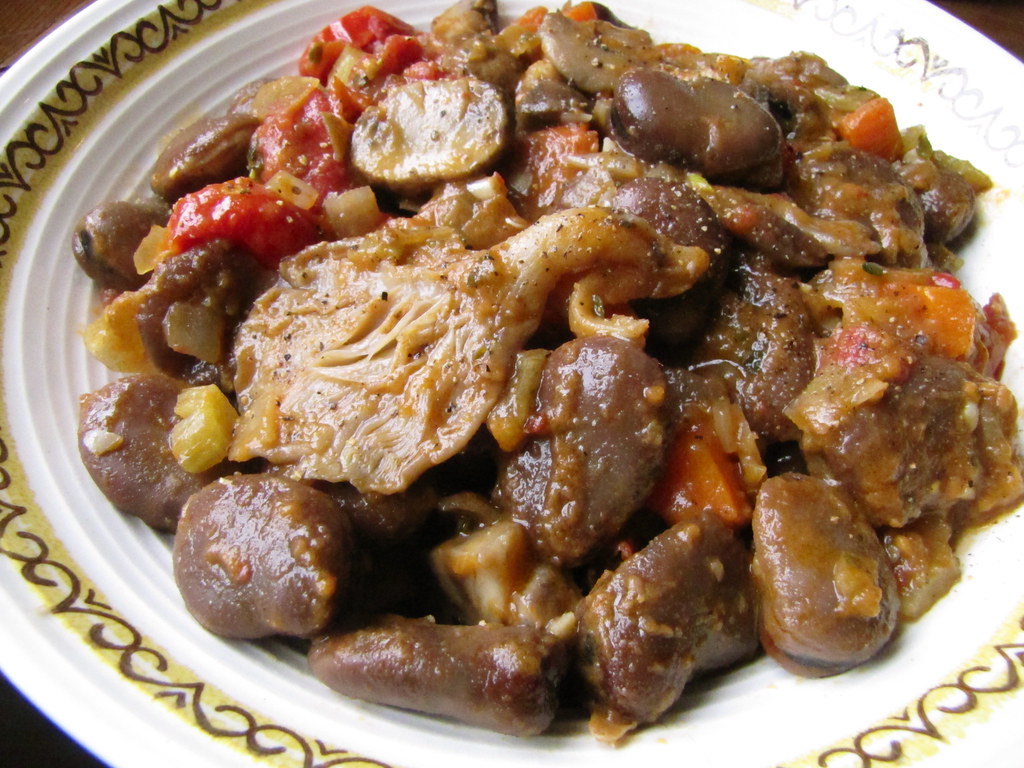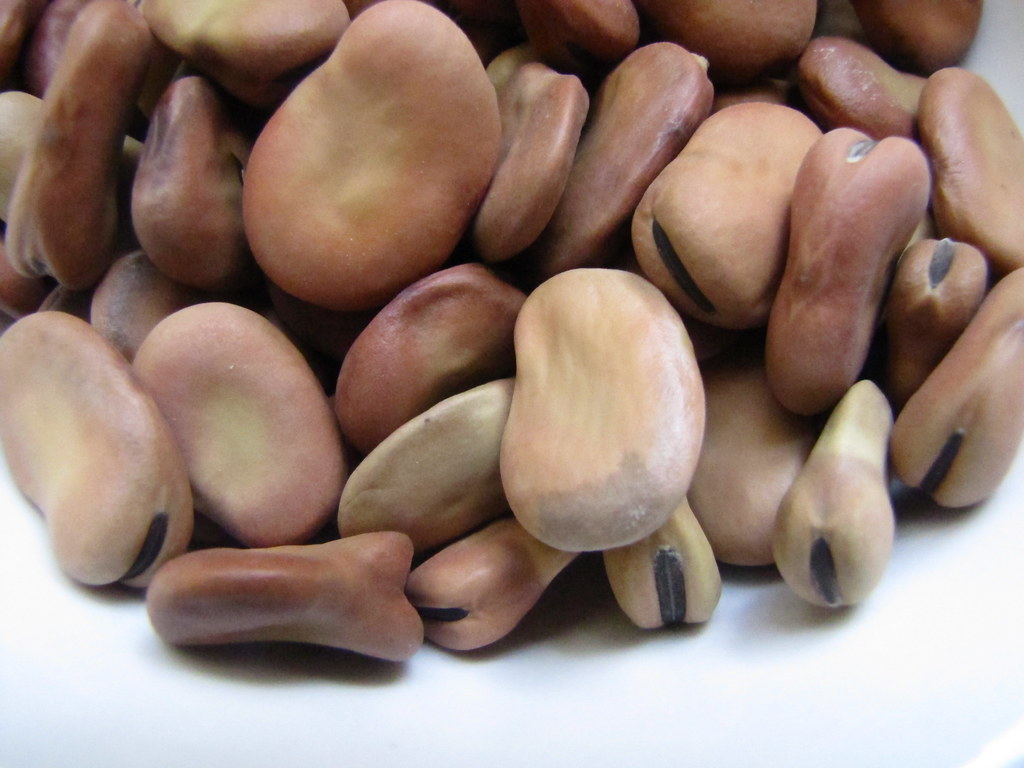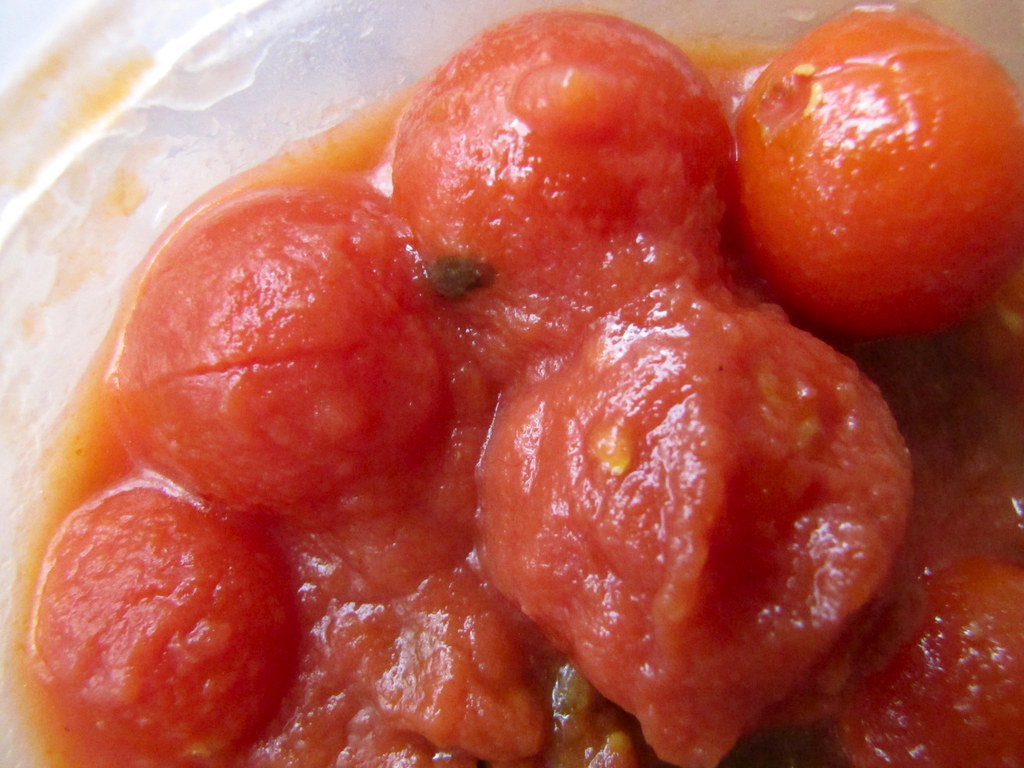In the summer, beans were for dressing in a gloss of olive oil, tossing with a confetti of crisp, chopped vegetables, and having as salad. In the winter, we simmer them with rich fats, sometimes with finely chopped (less colorful) vegetables, which dissolve into the resulting soup or baked casserole. While it’s definitely winter, I tried to make a compromise between these two polar opposite ways to eat beans. Starting with the king-size fava (or “broad”) bean, dried.
The dried fava bean is like a mollusk of the earth. Their sturdy, kidney-shaped skins hold inside them an ambiguously-textured mush, at least when cooked well. Unlike fresh fava beans, which we’re much more inclined toward when they’re in season, the dried, and reconstituted version is a lot more of a mouthful, it seems. They’ve lost their bright green color and much of their sweetness, and have transformed into carb-heavy bobules with thick outer skins. Kind of like how I feel in the middle of winter, too.
Because of the gargantuan size of these beans, I thought them more fitting for a stew, rather than soup. The recipe’s easy, and its flavor relies much on fresh thyme. I added some oyster mushrooms for a deeper, earthy flavor to complement the mushy beans. I’m not sure whether my fava beans had been dried fairly recently, but they took less time than anticipated to cook. An hour of simmering after a night of being soaked rendered them sodden sponges, with their sides just splitting open.
To turn the stew a rich, brown color and add welcome tang, I added a small can of cherry tomatoes (from Italy, and a surprise to find). These burst into the stew without my having to crush them by hand. If you can only find whole, peeled plum tomatoes, go ahead and crush them by hand before pouring them in.
The next day, I thinned the mixture with vegetable stock, and had as a soup. Try adding bacon to this in the first few steps, if you don’t have a vegetarian you’re cooking it for.
Hearty Fava Bean Stew
(makes about 6 servings)
8 oz. dried fava beans, soaked overnight
1 large carrot, chopped
2 celery stalks, chopped
1 large onion, chopped
4 cloves garlic, minced
1/4 cup roasted red peppers, chopped
16 oz. canned cherry tomatoes (or peeled plum tomatoes, crushed by hand)
about 3 oz. fresh oyster mushrooms (or a mix of mushrooms)
1 bunch thyme
bay leaf
1/2 tsp dried or fresh oregano, marjoram, or both
1 cup dry white wine
2 cups chicken or vegetable stock
salt and pepper to taste
extra-virgin olive oil
Drain and rinse soaked beans. Cover with 3 inches of water in a pot and bring to a boil; reduce heat to a simmer and cook uncovered until almost tender, about 1 hour.
Heat a couple tablespoons of olive oil in a large, heavy-bottomed pot or Dutch oven. Sweat the onion, carrot and celery over medium-low heat until soft, about 6 minutes. Add the garlic and cook another minute. Add the roasted red peppers and sautee another minute. Add the mushrooms and sautee another minute. Add the white wine and increase heat to let boil, while stirring, a minute or so. Add the tomatoes, stock, bay leaf, herbs and half the bunch of thyme, secured with string. Add the almost-cooked beans and bring mixture to a boil. Reduce to a simmer and cook, uncovered, for about 1 hour or until liquid has reduced to a thick stew. Remove bay leaf and thyme sprigs. Add salt and pepper to taste. Separate leaves from remaining fresh thyme sprigs and add. Garnish with good olive oil and an additional sprinkle of thyme.
Cost Calculator
(for 6 servings)
8 oz. dried fava beans (at $1.99/lb): $1.00
1 carrot: $0.30
2 stalks celery: $0.35
1 large onion: $0.35
4 cloves garlic: $0.10
1/4 cup roasted red peppers (jarred from the summer): $1.00
1 can cherry tomatoes: $1.49
abut 3 oz. fresh oyster mushrooms: $2.50
1 bunch thyme: $2.00
1 cup white wine: $2.50
2 cups vegetable stock (homemade): $1.00
olive oil, salt, pepper, dried herbs: $0.40
Total: $12.64
Health Factor![]()
![]()
![]()
Three brownie points: This one is way down there, again, as it can serve as a hearty, full meal. The fava beans are a good source of fiber and potassium as well as protein, although they are pretty high in carbs. (That’s why I didn’t add any potatoes to this stew.) When using canned or preserved ingredients, such as the tomatoes and red peppers, it’s always best to check ingredients to make sure they’re as pure as can be. You definitely don’t need to be eating calcium chloride or excessive salt, and home-canned versions are prone to tasting even better, too. This meal could use some greens, though, so have with a light salad on the side, or garnish with copious amounts of fresh, flat-leaved parsley.
Green Factor![]()
![]()
![]()
![]()
![]()
![]()
Six maple leaves: Again, think of reducing your carbon footprint not by where your ingredients came from, but what they are. Dried beans require much less energy and stress on the environment to produce than animal proteins, in addition to being cheap and healthy for you. This is a good recipe to use any preserved ingredients you might have from the summer, and tough winter herbs that can withstand the winter, like thyme. (Mine’s still growing… is yours?)



13 Responses
Chelsey
Looks tasty. You must have lucked out with the dried beans. The time I tried dried favas I boiled them for 2 hours and they were still on the crunchy side…
Lukas
When I cooked with dried favas the same thing happened—they cooked really quickly and were so mushy. And the smell! I actually haven’t tried cooking with them since.
Deena
Wow this looks absolutely good and probably taste delicious. I can’t wait to try this at home. I really seldom cook dried beans simply because I don’t know much of recipes on how to cook it. Thanks for sharing this recipe to us.
matt
I like the idea of trying fava beans, but this photo seems to be a little monotonously colored. Maybe some fresh herbs would change that.
@Lukas – why the smell? is that common?
Bambi-jo
Aren’t these beans you peel the outer shell off before cooking.Never heard they smell ,Do they? I have never cooked them but seen them cooked on food network, never heard them mentioning a smell. In these parts they do sell them . Mexicans supose to cook with them. But I never seen anyone buy them when I am there.
maria
The way my Portuguse mom tauhgt me to cook goes like this , make a cut on flat side of fava next to black eye ,then soak them for 24 hours .Cook the favas until tender ,not mushy.make the sauce with olive oil, red wine , fresh parsley, red crushed pepper, fresh garlic one choped onion. Mix all together .this is the clssic Potuguse recipe
cathy
Lukas: I thought the smell was rather bean-y and good! What was yours like??
Bambi-jo: Well, people normally peel off the first layer of skin from FRESH fava beans, as it’s tough. The dried fava beans have a pretty tough skin, too, but it’s impossible to peel when they’re dried. If you peeled them after cooking, they’d be completely shapeless mush. So, I eat ’em as is, with a soggy tough skin and all.
naomi dagen bloom
This worked perfectly for me with dried fava beans. Had never made them before, no idea where/when I’d purchased. And knew it was probably more nutritious to use entire bean with skin. Had not-delicious fresh tomatoes (it’s November in Oregon) that could use, a bit of organic tomato sauce and paste. Fresh thyme seemed crucial; other herbs dried. Thanks so much!
9 hearty vegan soup recipes | Mojo Central
[…] Hearty Fava Bean Stew—The Art of Eating In […]
Britta
Are you eating the skins of the dried beans??? You can do this with fresh beans, but not dried!! The skin will be, as another person mentioned, “soggy and tough.” The correct procedure is to soak them overnight, which makes peeling very easy (just pop the bean out). Then you can enjoy nice soft cooked beans!!
Butters
Didn’t know that there was a “CORRECT” way … soak the dried beans overnight … it works even better if you bring the dried beans to a boil for a few minutes, rinse them in cold water and soak them in the refrigerator overnight, then cook like any other beans until they are tender. If you peal dried favas you end up with mush, which is fine if what you want is paste. Favas are a different kind of bean, very earthy in flavor, they make a nice textural addition to a risotto.
christine Love
I cook fresh and dried Fava bean in soup and stew they are delicious and easy . for the dried fava it is better to buy the already shelled in Mexican market soak 6-7 hr with 3 times water, don’t need to soak overnight and cook with 3 times amount of water in 15 minutes and add any desires seasoning and add any meat that you like ( cook the meat first till tender then add the cooked fava bean last ( this way your bean will not be over cook and mushy)
Pat
I boiled the dried beans in just enough water to cover them for about three minutes. Then I turned the stove off and let them soak until the water temp was back to room temperature, about half and hour. At that point I slipped them out of the tough outer shell and discarded the shell. The remaining inner bean cooked to a nice consistency in about 20 minutes- chewy, but not falling apart and not crunchy. It was a pretty fast stew to make, all in all. And yes, diced bacon really adds to the flavor of the stew. It should be served with rustic bread for mopping up.